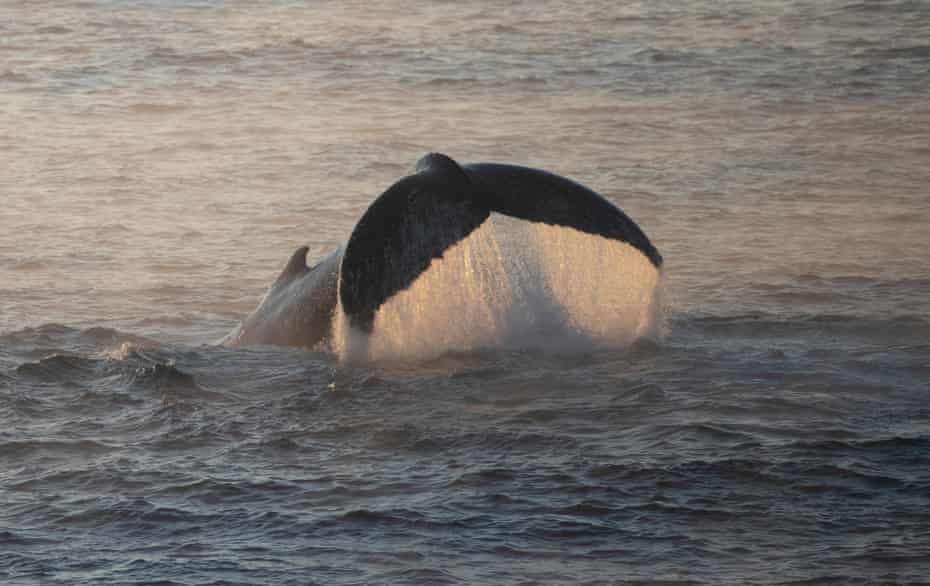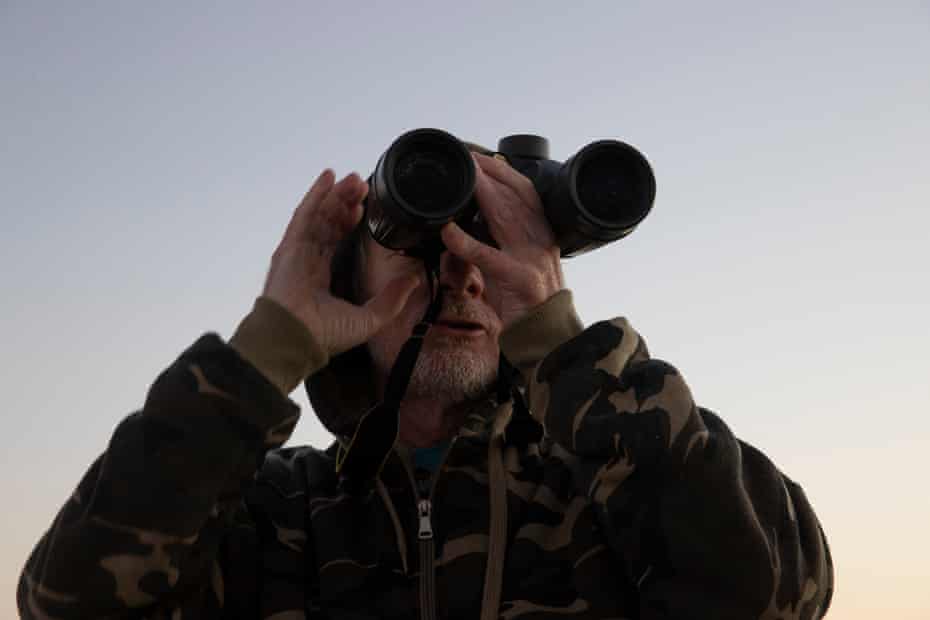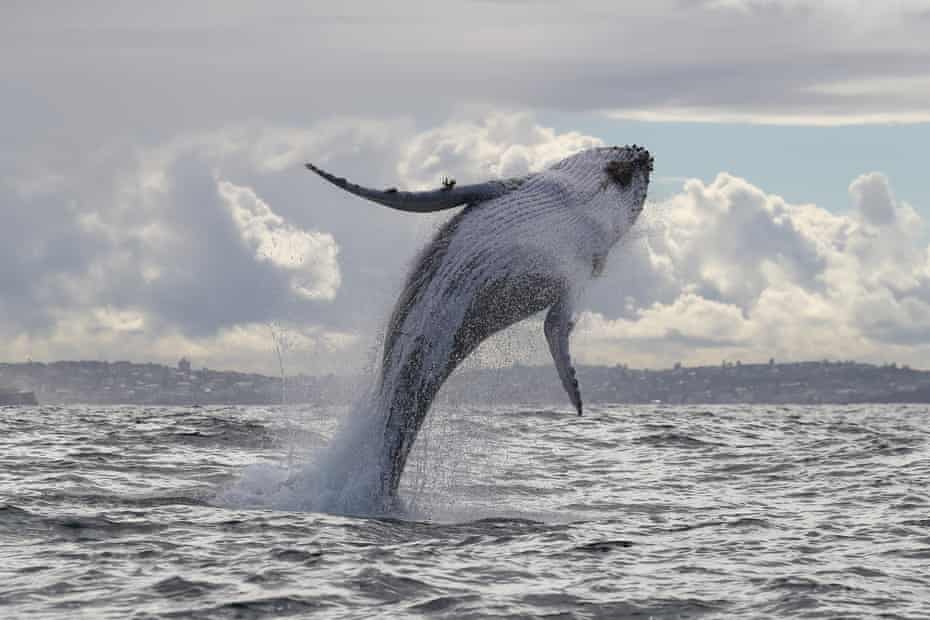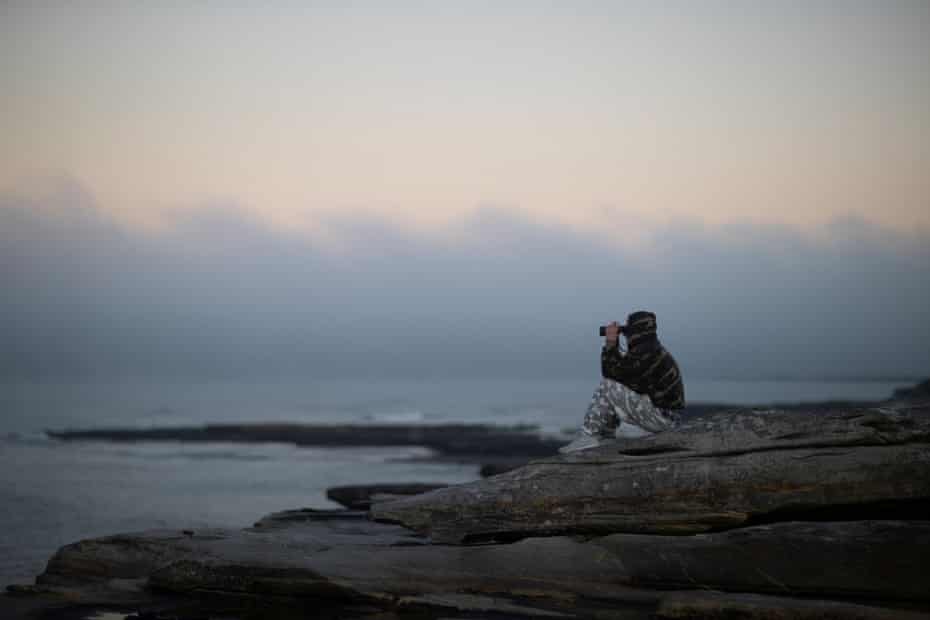He may have seen it tens of thousands of times before but when Wayne Reynolds spots a whale emerging from the water, he reacts with the excitement of a child pointing out a rollercoaster at an amusement park.
“Oh wow, there’s a minke and her calf,” he yells out with boyish enthusiasm from the rocky cliff at Potter Point in Kurnell, in Sydney’s south. “I just go into auto-mode, I can’t help it.”
It’s a cold Wednesday morning, the sun has only just made an appearance, and with the wind chill, temperatures are in the low single digits.
Reynolds is wearing a military camouflage-patterned hoodie and pants, and a wide grin.

Without gloves, his hands are gripping his binoculars, as he stands looking out into the Pacific ocean.
“Humpback! Humpback over there, he’s just put his tail up,” Reynolds shouts. The humpback is one of several species he is able to recognise by the skin pattern on its tail – a skill he has developed in more than 20 years as a citizen scientist observing the mammals.
This whale is swimming so close to the coast that its size is confronting – Reynolds estimates it is about 15m long, and must weigh about 40 tonnes.
“That’s a big girl, that one. The girls are bigger than the males,” he says, as she slaps her tail repeatedly.
“That could be a communication with other whales, or just slapping off barnacles. Or there could be something annoying her,” Reynolds says.
Heavy fog makes some of the whales difficult to spot that morning, but Reynolds’ trained eyes can detect their presence from a vortex of water generated by the movement of their tails, which he says “creates a circle like an oil slick” on the surface.
It’s several weeks into Sydney’s watching season, when whales migrate from the Antarctic to warmer waters off the Great Barrier Reef to feed and breed through the winter.

Surrendering most of the daylight hours during these months to watching whales is nothing new for Reynolds, but where he watches them from has changed.
Potter Point is at the south end of Botany Bay national park, a temporary vantage point where Reynolds and fellow volunteer whale watchers have set up while a whale-watching platform is built at their traditional base at Cape Solander, at the opposite end of the park, where they began watching from a carpark decades ago.
Having retired as a diesel mechanic at the age of 27 in 1992 after being diagnosed with chronic lung disease, Reynolds was facing a future “sitting at home bored shitless” on a disability pension.
He saw a newspaper ad to volunteer for WIRES wildlife rescue, and after being involved in some whale rescues, and seeing the mammals up close while jet skiing off Cronulla, he became fascinated.
“You’re witnessing one of the biggest living animals in the world. There’s an awesome power of the whale, I can’t really explain what else keeps me coming back.”
In 1996, Reynolds began watching whales regularly from Cape Solander, and a year later led a pilot program in coordination with the national park to record observations in a serious manner for the duration of the migration.
The study officially launched the following year, and has attracted untrained citizen scientists, as well as volunteer marine researchers and the rescue group ORRCA, as the whale watching movement grew.
In the 24 years since, study volunteers have monitored whales from 6.45am until 4.45pm for the duration of the season.

In the early years, the group sought to keep standards as rigorous as possible. Reynolds remembers securing military-grade night vision equipment and camping out with fellow volunteers to attempt to record whale movements 24/7 in continuous shifts.
While night observation has not been maintained, interest in whale watching has blossomed. At the peak of the season, thousands of people flock to Cape Solander, and whale numbers have soared in recent decades.
Reynolds saw about 150 whales in his first year of observations from Cape Solander. In 2019, he saw more than 3,000, with more than 100 on some days.
His observations have been backed up by scientists, who have incorporated the Cape Solander whale migration study’s findings into their own research.
Dr Vanessa Pirotta, a marine biologist from Macquarie University, says southern hemisphere humpback whales were hunted to near extinction by the 1960s, but since then their numbers have steadily grown, recovering to their first observed population sizes by 2015.
With populations expected to peak at 40,000 over the next five years, there are even calls to delist the humpback from the threatened species list.
Pirotta cites these growing numbers as proof of successful conservation efforts, and says the contribution of Reynolds and his fellow volunteers has been instrumental in documenting the whales’ resurgence.
Pirotta acknowledges the citizen scientists have not been academically trained and don’t have access to certain measurement technologies, but says the figures they generate correlate with systematic surveys conducted in Queensland later in the migration.
“We have had Wayne there throughout the entire study period, training people and overseeing it. That gives us confidence in the effort.

“The amount of observation hours they have put in is just amazing. The cost of carrying that out in a funded scientific project would be impossible, you can’t achieve that level of observation.”
Pirotta first met Reynolds while studying for her master’s degree, and has collaborated with him since gaining her doctorate, including co-authoring academic journal articles based on his findings.
While researchers like Pirotta would come with theodolites to precisely measure distances from coastlines, Reynolds continued using binoculars. He claims to be able to guess distances within 20m of official accuracy.
Pirotta finds Reynolds’ passion infectious.
“Wayne and I would be side by side all day, every day. It’s Wayne’s whale world,” Pirotta says.
“I love Wayne, I could sit in front of the ocean with him for hours.”
In 2019, Reynolds retired from leading the study. He has turned his passion to photography, and spends several days a week taking photos of whales on commercial tourist vessels.
His trips to Kurnell may be less frequent, but when he visited last week, volunteers at Cape Solander treated him as a legend of the operation.
As heavy fog worsened and entirely hid the ocean, they retreated to a temporary shed set up for them, and filled Reynolds in on recent happenings.
“There’s no whales right now, but at least we get to see Wayne,” one says.